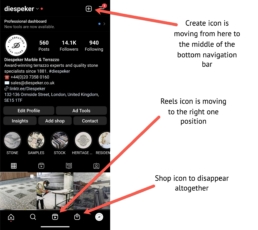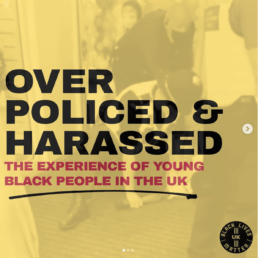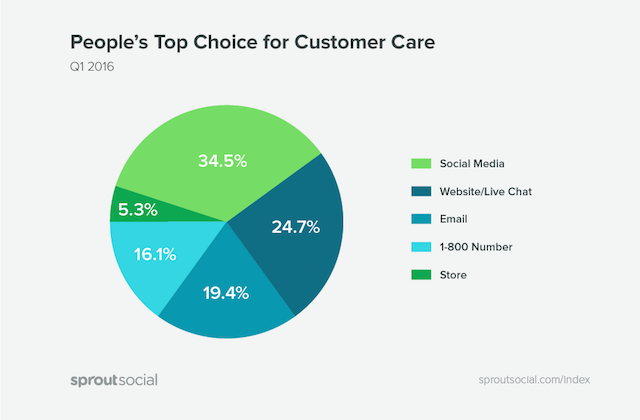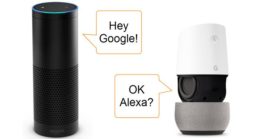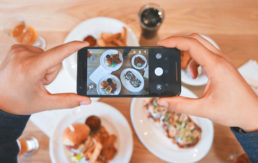Instagram update sees shopping cart exit left
An announcement this week let the world know that Instagram will soon be updating its user navigation to ‘simplify’ things for everyone.
The biggest change sees the shopping bag Shop shortcut icon disappear from the app’s home screen navigation altogether. The news has generally met with approval among users who have felt that the commerce side of the app has, over the past few years, been forced front and centre at the expense of its more creative shortcuts. The move will see the Create button move from the top right navigation to, once again, be the most central icon on the main navigation bar with the Reels icon making way by moving one step to the right. The Shop icon will no longer be seen here at all.
Does this signal a change in direction for Instagram?
Don’t panic (!) – buying and selling on Instagram is here to stay and will continue to be easily accessible via the Discover shortcut (the magnifying glass one) as well as direct from Posts, Stories and Reels. But placing the Create shortcut front and centre once again could be seen as an attempt to prioritise creativity over commerce for the average IG user experience. And we like that.
What’s also interesting is that the ever-so-slight re-positioning of the Reels shortcut may signal acknowledgement that the IG powers that be have taken on board the ‘Make Instagram Instagram Again’ backlash from users who are unhappy that the app seemed to have been copying TikTok more and more since 2021.
The new Instagram changes start to roll out this February.
See how Head of Instagram Adam Mosseri announced the changes >
The rise in infographics on Instagram
If you are familiar with the social media app Instagram, you will know that its main purpose has been, traditionally, to share selfies and snapshots of one’s lifestyle. But there has been a significant rise in the use of educational infographics flooding everyone’s news feed, particularly in response to the Black Lives Matter movement.
Let’s take a look at how this has changed the way we use Instagram and how it promoting societal change for the younger generation.
What is an infographic?
An infographic is defined as ‘graphic visual representations of information, data, or knowledge intended to present information quickly and clearly.’
Instagram offer an image carousel with a maximum of 10 slides, which you can fill with whatever you like.
Users can take advantage of this feature, posting tailor-made graphics, with bold text, to explain elements of bite-sized concepts. They have proved to be a successful tool for education and spreading awareness, considering most young people consume most of their news on social media rather than on traditional news outlets.
The catalyst: Black Lives Matter
The trend of the Instagram infographic really came to the forefront following the tragic murder of George Floyd at the hands of a police officer in the United States. Our newsfeeds filled with selfies quickly turned into mini slideshows packed with cries for justice and equality, to define relevant words and phrases, and resources on how to support the Black Lives Matter movement. This trend was picked up by not only the everyday users but also celebrities and influencers who had vast followings on the platform.
Since then, the infographic had been adopted by other causes and is used frequently all over Instagram as a way to circulate information and educate on specific subjects or topics. They seem to spike when explaining especially complicated/heated political or social topics, such as for sharing the experiences held by women of sexual harassment in the light of the Sarah Everard case, or the Israeli-Palestinian conflict.
Here are some examples of how infographics are being used as an activism tool on Instagram at present:
@SophJButler posts a weekly ‘Sunday School’ graphic educating readers on specific issues regarding disability.
@everydayracism_ Graphics to educate on the subject of racism and how it can be challenged.
@theslowfactory Frequently upload carousel posts on a variety of topics using tailor-made graphics and citing sources along the bottom
How the infographic can be used for your business
The infographic is a brilliant way to condense a fair amount of information into a singular social post, which can be beneficial to a business selling any kind of product or service.
For example, Brigstock Skin & Laser who post infographics to their Instagram account to promote their monthly offers or to provide information surrounding their expertise.
Infographics can be utilised as a tool to answer frequently asked questions at a glance. This lessens the likelihood of a user dropping off because it has proved to hard to get the answers they needed.
Each slide of the infographic can be posted as an individual story for more exposure and saved to a highlight reel for future users to find.
The infographic tool allows a brand to share snapshots of what they are offering, without wordy, lengthy and frankly overcomplicated posts. Providing a call to action in the final slide or in the caption will allow users to find further information on your website, thus promoting traffic and hopefully leading to greater conversions.
How to get started with infographics
- The free tool, Canva, is going to be your best friend. It is a library of pre-made, fully customisable, social media content – including premade carousals and infographics! The great this is, you don’t need any prior experience with graphic design to get the most out of Canva.
- Customise your posts to reflect your branding and stick to your own colours and fonts. If Canva does not have your font in-built, you can upload it manually. Likewise, you can upload your own icons, images and logos.
- Keep the information concise, with a clear message, keeping to your brand’s tone of voice.
- Do not overpack each slide with text. It is best to make use of the 10 slide maximum to spread out the wording. Whilst you can download ready-to-go infographics with the text included, it is best to edit them so that people don’t recognise it from elsewhere and so it reflects your company’s mission.
- Put a small watermark on each of the slide, so that others cannot repost your content without crediting your business. This could be with a logo or with your Instagram handle.
Whether this is your introduction to infographics or you wanted to find new ways to make your infographics more effective, one thing is for sure, they have made a huge impact in all corners of the digital world and every marketing and social media professional should be embracing them – as they are clearly here to stay.
It ain't all bad: 10 reasons why social media is GREAT
Social media has a somewhat shoddy reputation. This has only been heightened by the recent Cambridge Analytica scandal on Facebook. But you know what? It's not all bad - it's actually pretty great.
Three billion people (about 40% of the world’s population) use social media, and we’re spending an average of two hours every day sharing, liking, tweeting and updating on these platforms. So, with social media playing such a big part in our lives, it’s no doubt that news channels and various professionals are picking up on the negative effects of socialising behind a screen.
We’re here to tell you about the positives, and trust us, there are plenty. We’ve whittled it down to our top 10 reasons why social media is truly great.
1. Communication is even easier
It’s undeniable that social media increases the ease of communication in a world where people are more mobile than ever before. Facebook Messenger and Skype are the glue bonding long-distance friendships and families. It also offers a type of freedom to people who found traditional forms of communicating difficult; many marginalised groups, such as the elderly and disabled, have created online communities that connect them to people all over the world, or even just down the road. Suddenly, even if you are physically isolated, you can still feel connected and sociable.
2. Creating communities
In a similar vein, social media connects like-minded people into communities where they feel safe to discuss different subjects without being ridiculed. Movements like ‘March for our lives’ and ‘#MeToo’ have gained a large majority of their support and grassroots activists through social media. By using hashtags, social media users can create communities that align with their beliefs and provide support (online and in real life). This is a great example of how social media can be misunderstood as a singular activity when really it excels at bringing people together.
Social media connects like-minded people

3. Generating job opportunities
If social media did not exist, I would not be sitting here writing this article. Not because this article is about social media, but because that is my job – to manage social media accounts. Not only that, but younger generations like millennials have really cottoned on to the value of social media as a legitimate brand platform – Justin Bieber was signed to a successful record label after proving his saleability and talents uploading covers and original songs to YouTube. Likewise, Ed Sheeran’s initial success was related to his presence on the video platform. What’s better is that as fans we feel closer to these celebrities – we have literally watched them go from bedroom singers to sell-out arena artists thanks to social media.
4. Engaging with customers
Many tech-savvy businesses benefit from having a social media presence, after all, that’s where their audience is. Not only can businesses use it as a tool to increase customer engagement, but customers use it as a tool to contact companies for enquiries and complaints. Twitter is a great example of this, with many large brands having dedicated customer service accounts where customers can get replies within minutes.
5. Free lessons in pretty much anything
Have you ever watched a ‘how to’ video on YouTube or Facebook – be that make up tutorials, solving software issues, playing instruments, cooking dishes, gym workouts, etc? Congratulations, you’ve used social media to learn something new! More than ever, we are reaching for our phones to find the answers to everything and anything.
6. Breaking news faster than ever
Nothing spreads faster than news on social media. Whether it’s a football club signing, a terrorist incident, a political upset, or a famous couple ending their relationship; chances are, it’ll be trending on Twitter before you can say “Donald Trump”. Twitter is great at breaking the news but problematic at qualifying the facts. After the initial story breaks, the lines between facts and fiction can get a bit blurry, especially on Twitter where 328 million monthly active users can pile in with opinions. But it’s worth remembering that while mistakes can be made more quickly than traditional media, they can also be fixed just as quickly.
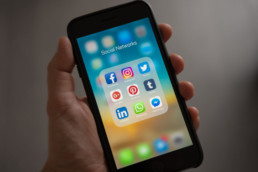
Twitter is great at breaking news
7. Sending messages of safety
One of the most useful features Facebook has developed in the past few years is a ‘mark yourself safe’ option, Safety Check. This feature was first established during the devastating earthquakes in Nepal in 2015 but have since been used in acts of terrorism in Paris, Brussels and London. You have the option to mark yourself as ‘safe’ after an incident or natural disaster in your surrounding area, so your friends and family all over the globe know you’re OK. Features like this can relieve some of the pressure off overloaded infrastructures where disaster has struck.
8. Communal learning
One unlikely outcome of the meteoric rise of social media use is a better communal understanding of some subjects. Cast your mind back a month or so and you may remember social media raving about an audio clip that divided listeners. Some of them could hear ‘Yanny’ and some of them would hear ‘Laurel’ – we bet if it did find its way onto your feed, you now know why we hear different names. This is a learned experience; something you have learnt simply from the hype of social media. Although they seem trivial trends and tend to be over in a day or two, some pretty interesting articles have been written about what we can learn about ourselves from these communal discussions.
9. A global marketplace
The integration of online shopping into a selection of different apps has made it easier than ever before to make purchases (we’re counting this as positive, but your bank balance might not agree). This isn’t just about YouTube and Instagram influencers trying to tout their newest clothing collaborations; Instagram has enabled many designers, photographers and illustrators to curate followings and sell their work to audiences all over the world.
10. Social media gives everyone a voice
The final point to be made is that there are no gatekeepers when you publish via your social profile (aside from each platform’s terms of use) – you can write anything, and anyone has the chance to view it. Social media tends to be more democratized than traditional print media (which hasn’t always offered the most representative sample of voices) and it has given everyone a medium through which to express themselves.
There you have it – our top 10 reasons why social media is great. Considering the improvements that social media has made to lots of aspects of our lives, as evidenced above, it seems a little harsh to write it off in one fell swoop.
What do you think, have we persuaded you into giving social media another chance?
Is social media targeting ads based on our conversations?
Have you ever mentioned a product in spoken conversation only to be advertised that exact product on social media hours later? We have.
There could be a number of reasons for this, but we’re going to discuss the two most plausible explanations: either algorithms are much more sophisticated than we think, or companies are listening to our conversations through our mobile microphones. So which is true?
We feed sensitive information to all sorts of hungry machines from the moment we wake up until the moment we fall asleep. In fact, some of us track what’s happening to us even whilst we sleep. Our devices and phones know where we are, the route we used to get there, who we’re likely to talk to, and can predict when we’ll be on the move again. And that’s readily available information – think about what we manually input; Do you take photos of your food? Do you track your steps and calorie intake? Do you monitor your heart rate and sleep pattern? Do you use internet banking? Technology knows a lot about us.
Over the past few years users have suspected social media platforms of listening in on conversations through mobile phone microphones. For good reason too, as with the emergence of virtual assistants (Siri, Alexa, Cortana, Google Home) we’re talking to technology more than ever. But here’s the conundrum: how much of this information is shared? I’m not the only one who has been targeted with extremely particular advertising on social media. So how do the likes of Facebook know what I’m talking about?
Theory one: our phones are listening to us
Do our phones listen to our conversations?
Google and Facebook categorically reject accusations that they are listening to our conversations to advertise to us. The thing is, this doesn’t mean they aren’t listening. As pointed out by Terra Ferma Media MD David, if you have an android phone, Google IS listening to and recording your conversations. It’s highly likely that Apple users have the same issue, but there’s no way to turn this off yet. So they’re listening, but both social giants insist they aren’t using this information for advertising. Facebook released a statement about this in 2016.
Google has a developer policy that all app developers must agree to that specifies apps must not breach privacy in this way (you can get lost in the policy here).
It’s also worth reminding you that Facebook owns WhatsApp and Instagram. Google owns YouTube and Google Maps. The point is these companies have a lot of information about us, whether we like it or not, and are using this information to their advantage.
Theory two: it's just a clever algorithm
Is it just a clever algorithm?
Every social media platform is governed by algorithms. Twitter is a good example of this with its trending topics; a live, fast-moving algorithm that displays the most popular topics based on a number of rules (how many people are talking about the topic, at what speed the topic arose, how many verified users are talking about it, if it’s a breaking news item, etc).
Facebook probably uses the most advanced algorithms in the game. The benefit Facebook has over other platforms is the plethora of your friends’ data. Facebook knows who your family is, who your partner is (and ex-partners), and who your closest friends are based on interactions. You and your close friends probably have a similar way of thinking, or are interested in similar topics, so Facebook will assume that anything your closest friends are talking about will be of interest to you. This also means whatever your friends are searching for, reading, liking, hiding, and following could also be of interest to you. This is how clever targeted advertising comes into play.
We also can’t ignore the fact that companies advertising on Facebook have a huge range of data available to them. They can target people living in certain locations of particular genders and ages, people who attend certain schools or workplaces, commuters, people with particular interests, and so much more. Combined, these two methods of data gathering is probably the outcome of the adverts you’re seeing. No hocus pocus.
Our advice? Keep talking.
Finally, to cover all bases, we need to mention cookies and remarketing. A cookie (apart from being delicious) is a small code left on every web page you visit, telling the website owners which pages you’ve clicked on. Take Amazon: you’ve probably browsed something on the Amazon website only to see that product advertised to you on Facebook too. This is because Amazon remembers what you’ve looked at (via a cookie) and uses their advertising space on Facebook to show this product to you again (remarketing). Even if you searched for something months ago, if Amazon wants to sell it to you, it will advertise that product to you.
So where does this leave us? Facebook and Google both deny using the microphones on our phones to listen in to our conversations for advertising purposes. Can we believe them? On the algorithm side of the coin, there are three things at play:
- Sophisticated algorithms taking data from your extended friendship groups
- Companies having excessive amounts of advertising data to target specific audiences
- Social platforms storing information about your online habits
These factors combined make a convincing case that could make you think you’re being listened to. It really is that clever.
Ultimately we don’t have the magic answer, and of course if large companies were indeed using our conversations to advertise to us, they wouldn’t exactly shout it from the rooftops.
Our advice? Keep talking. While there’s no evidence of any wrong doing, if you are being targeted with relevant ads, then what’s the harm? If you’re that worried why not start talking about the lottery and see what happens. You never know…
Real news about fake followers
Director David Fernando sounds off about fake followers on Twitter (in other words, cheats). He writes:
News this week claims that up to 50% of Donald Trump’s Twitter followers are probably fake. That’s genuine ‘fake news’ I guess. But how do we know?
When Trump announced his candidacy for President, his Twitter account had just over 8 million followers. Today that number has swelled to 31 million. Perhaps not surprising for POTUS but according to a wide variety of sources including The Metro, Newsweek and others – 14,776,939 of these are not real people, they are most likely to be automated “bots” – paid for by the account owner.

Why? Simple. Vanity and power. A high number of fake followers can artificially boost the perceived popularity of social media accounts thus positioning the owners as influencers. You don’t have to look far to find other examples of this dubious practice, in even your local neighbourhood (and, yes, we all know who you are in Wimbledon).
Fake followers can be bought online for around $90 per 10,000. True, not all fake followers are bought, and every account will probably have a small number. But an account that has a significant number of them has probably acquired them illegitimately in an attempt to dupe people.
Accounts that have (seemingly) popular social media accounts can help win business and influence people. They can also inflate the social media assets of their company and therefore apparent value (although any decent due diligence would quickly uncover the truth).
And how do you find out the truth? Well, there are many ways. You can even try it yourself for any Twitter username here: Twitter Audit or here: Fakers.
It’s not a fake fact that when it comes to social media, sadly many businesses are still convinced that a large number of followers is more important than good levels of engagement. But, as a sensible business knows, the real value is not the number of followers you have but the levels of engagement you achieve via your social media activities.
“Why does any of this matter?”, I hear you ask. Well, in the grand scheme of things when famine is about to claim millions of lives in Yemen, the honest answer is, “It doesn’t”.
However, in a world where the social media giants are under increasing pressure to root out deception in their channels, it still resonates and should be addressed.
5 things beginner Social Media Managers should know
With 2.3 billion people using social media, it's no surprise that it has become a key pillar of companies' business strategies.
Major brands have dedicated teams looking after their social channels, but what if you don’t have the capacity for a social media team? If you’re about to embark on managing social media accounts, we think you’ll like these tips.
1. Use a dedicated Facebook account.
You’ll thank us for this one. To become an admin of a Facebook page you must link the page to a personal account. This means, day and night, you will receive notifications from business pages linked to your private account. You’ll be bombarded with likes, comments, and analytics from business pages and your personal notifications will become few and far between. So, create a new Facebook account to keep your personal and work accounts separate. If you need to keep on top of things you can still receive notifications, but if you don’t want to receive them out of working hours, you don’t have to. Bliss.
2. Audit, audit, audit.
It’s difficult to measure ROI with social media, but something you can track is the number of followers, reach, likes, comments and shares. Keeping on top of progress is essential for figuring out what sort of campaigns your audience responds to. Audit your channels once a month (always on the same date) to keep track of progress (or lack of). Improvements can always be made, but you need to know what’s working – and not working – beforehand.
A well thought out content plan will keep you and your client on track.
3. Create a content plan.
If you want to ‘do’ social media well, you need to plan. Posting ad-hoc day-by-day isn’t good enough when it comes to successful accounts. Yes, you need to stay current and keep an eye on the day’s news, but preparing a monthly plan is imperative. Outline key social dates as well as key dates for your business (product launches, offers, events). Your plan doesn’t need to be fancy – we use a Google Sheet – but make sure it’s clear, you include all social channels, and you have a way to share this information with other employees or clients. Hootsuite has a free social media plan you can download here.
4. Keep up with the Joneses.
Who are your competitors? What are they doing on social media? What’s the latest feature on Facebook advertising? What are the popular hashtags on Instagram? Don’t get left behind – social platforms release updates and new features all the time, and if you’re not in the know, you’re already lagging. We like to keep up with Mari Smith for Facebook updates, she really knows her stuff.
5. Have clear goals.
This might sound obvious, but it’s easy to get side tracked. Are you using social media to increase footfall in-store? To raise brand awareness online? To encourage conversation and interaction? To sell something? Whatever your goal is, stick to it. There’s not much point in advertising online if customers aren’t coming in-store – why not create an online offer that’s redeemable in-store only? Always keep your main objectives in mind.
What's happening with social media in 2017?
The social media world moves fast.
While it’s pretty much impossible to predict what will happen to social media this year, here are a number of trends you should keep a close eye on in 2017.
1. Paid content continues to soar
It’s extremely difficult for businesses to reach their audience with organic content. The answer to this problem is paid content (adverts), which is fast becoming a dog-eat-dog world as competition rises. Brands are paying more than ever to be seen online. Social media ad spend is estimated to surpass $41 billion in 2017.
2. Social commerce shakes up online purchasing
Customers want products, and they want them now. With 75% of consumers making a purchase because they saw it on social media, it’s no mystery why brands are bending backwards to sell on social media. Instagram’s instant purchase feature (a button under an image) is set to soar, and businesses are creating Instagram-specific pages where all items featured in a photo are listed. Brands are tapping into their follower’s emotions for purchases – 28% of consumers said a brand’s social presence was the biggest reason to try new products or services.
3. Customer service becomes a priority
34.5% of people choose to contact brands through social media for customer care, beating website/live-chat, email and phone methods (see below). Complaining on social media is public – everyone can see complaints – which forces brands to keep customers happy and up their reputation. The positive of this is that if your social media management is good, customers will also see you’re great at responding to issues. If it’s bad, well… You know the drill.
4. Millennials are moving away from Facebook
While Facebook still remains extremely popular, it is actually becoming more popular with non-millennials. 41% of millennials use Facebook every day, but it is their least popular social media platform, preferring YouTube, Instagram and Twitter. For younger millennials, disappearing content platforms are the bee’s knees. The allure of disappearing content is too tempting to ignore, with Snapchat reigning and Instagram following suit with Stories. Make sure you know where your target audience are hanging out online.
5. Live video
We can’t mention social media and 2017 without talking about video. In this case, live videos will dominate in 2017. Nothing is more in-the-moment than live video, and Facebook, Twitter and Instagram already offer brands the opportunity to create live videos. News channel CNN used a Facebook Live video during the inauguration of President Donald Trump, which gained over 4 million viewers.
Shhh! The walls have ears.
2017 is shaping up to be the year of the digital assistant.
Devices featuring voice recognition digital assistants took CES by storm this year. Intelligent, voice activated digital assistants abound. Amazon has Alexa, Microsoft has Cortana, Apple has Siri and Google has… well, Google.
Amazon’s Alexa stole the show as it seems to have gained first mover advantage by not only featuring successfully in the popular Amazon Echo device, but also being the voice recognition system of choice for other companies producing everything from media streaming to fridges.
I think people are just waking up to the possibilities for – and dangers of – this technology.
We were amused by the story of a 6 year old girl using Alexa in her parent’s Amazon Echo to order herself a dolls house. When the news was reported on local TV in San Diego, the words spoken by the newscaster triggered other Amazon Echoes within earshot of tuned-in TVs to perk up and attempt to do the same. Ooops.
The trouble is – that’s how easy it can be to voice activate these digital assistants. They hear their trigger phrase (or think they hear it) and off they go. I’ve often seen my Google phone activate when it thinks it hears me talking about the Google Assistant (normally using the words, “OK Google” as part of a wider conversation on the topic).
"People are just waking up to the possibilities for – and dangers of – this technology."
Should we be concerned about this?
Maybe. You may or may not know that Google already records and retains all your Google activity. This includes keeping an audio transcript of everything you say whenever you activate Google’s digital assistant. Alexa does the same thing. You can review and delete these messages, but they are there.
You can see your Google audio transcripts by visiting https://myactivity.google.com and filtering the content to “Voice & Audio”.
When we tried this, we found that many snippets of conversations had been captured and could be replayed at the touch of a button. This included personal or work related conversations that could have included sensitive material. Try it yourself, it’s a little unnerving.
We’re not discussing anything nefarious here – but why does this make me uneasy? The thing is, these tech firms say they need to capture and retain this content to help fine tune the accuracy of their digital assistants. Maybe…but still.
On that note, whilst Alexa is the star of this year’s CES event, newly arriving Google Home (not yet available in the UK) may yet win the race. The search giant may be a late comer to the personal assistant device party but it’s own Google Assistant should, on paper, have access to a wider range of information than Amazon.
If only it had a more personal name than “Google”. My bet is that it will sooner than we think.
Digital businesses boom in London
London is open.
Facebook, Google and Apple have announced major expansions in London, proving the capital is open to the world’s biggest brands and is the leading city for trade and investment.
Facebook announced they will be doubling their presence in the UK by opening new headquarters in London’s Fitzrovia. The new hub will open in 2017, creating 500 additional jobs including engineers, marketers, project managers and sales staff.
Google, who already has a London HQ, is moving 2,500 staff into brand new digs in King’s Cross. The new 371,000 sq ft building consists of 11 floors and even includes a 90m running track for employees to let off some steam. Rumour has it the tech giant has snapped up a number of nearby properties, suggesting further developments in the future.
Rumour has it Google has snapped up nearby properties for future developments.
Earlier in the year Apple revealed that they will be making Battersea Power Station their new headquarters, spending an eye-watering £9 billion on the project. Apple will be moving 1,400 staff from multiple sites around the capital into their new campus, expected to be open in 2021. Apple will occupy six floors (500,000 sq ft) of the Grade II listed former electricity generator.
London’s position as a global technology hub isn’t showing any signs of slowing down anytime soon.
Up your game with these 9 Instagram hacks
It's tough in the world of Instagram.
With over 500 million active monthly users, it can be difficult to find and interact with your ideal audience. Are you struggling to create content that people like, or failing to gain engagement and followers? Get the most out of Instagram with these nine hacks.
1. Hashtags
Did you know the most popular Instagram hashtag is #love? A sure-fire way of getting more likes, followers and comments is by using hashtags. Use appropriate (repeat: appropriate) hashtags on your posts and you’ll find your engagement rates sky rocket. You’re allowed to use up to 30 tags per post, excluding comments, which means you can comment on your own photos with extra hashtags to reach more people. Do some research about what your competitors are tagging and, if you can think of a use for it, create your own hashtag.
2. Lighting
Instagram is all about photos, and good photos need great lighting. A well-lit, naturally bright photo will always get more likes than a dark photo. It’s a no-brainer. Try to take your photos in a light room (or outdoors), but stay away from harsh sunlight.
3. Angle
Know your flat lays to your FWIS’s. Products, food, clothes and more can benefit from flat lays. Essentially this is taking a birds-eye view photo of your subject laid flat on a surface. Check out @flatlays Instagram account for inspiration. FWIS (From Where I Stand) is another popular Instagram angle, which creates a sense of viewing life through someone else’s eyes. Just make sure you have cool shoes on. Check out @fromwhereistand.
4. Filter
Instagram’s own filters are sufficient for some, but not us. We love Ludwig, Juno and Crema, but sometimes it’s just not enough. Use your phone’s inbuilt photo editing software or our favourite app, VSCO, for more editing options. VSCO has hundreds of free filters to choose from and, better yet, you can upload a VSCO edited image to Instagram and continue to edit in-app. Your editing options are endless, just don’t go OTT. Once you’ve found your favourite filter style, try to stick to it.
Know your flat lays to your FWIS’s.
5. Captions
Keep them short, sweet, informative. Think of it this way: if you’re posting a photo of your dinner, we already know quite a lot about your meal. You might want to tell us what it is, if it was nice, or how to make it. Instagram users scroll through photos quickly, so you don’t have much time to grab their attention. Chuck in an emoji if you’re feeling fancy.
6. Timing
When’s the best time to post on Instagram? Good question. Start with your audience demographic. How old are they? If they’re of working age, posting during working hours should be avoided. Where do they live? Don’t forget about time differences. If your audience is in the UK and USA, posting in the evening (UK time) is a good place to start. When is your audience online? At school, whilst commuting, whilst the kids are at school, in the evening, etc. Think about your audience, combine these answers and you’ll find your perfect time to post on Instagram.
7. Links
Instagram does not like links. No one will copy a link and paste it into their phone’s browser, so don’t bother pasting a link into the caption of your photo. The only way around this is by changing the clickable link in your Instagram bio. If you’re releasing a new product, plugging a blog post, or referring to a recipe, pop the link in the URL section of your bio. Change this link before you post or immediately afterwards – IGers are fast movers.
8. Take advantage of Instagram’s apps
Instagram is not a one-app band. In fact there are three official sub-Instagram apps to enhance your Instagram experience. Boomerang adds fun to your stream by creating short, snappy videos that play on a loop (a bit like Vine, but shorter). Layout answers all your photo mosaic prayers, giving users a number of – you guessed it – layouts to input multiple photos. Hyperlapse creates stabilised time lapse videos that allows you to edit the speed of the video.
9. Engagement
Believe it or not, Instagram isn’t just about cool photos. There are real people behind Instagram accounts, and they like to talk. If someone comments on your post, don’t ignore it. Respond to get the conversation flowing. In the same breath, spend time commenting on other people’s posts, too. You’ll find that this helps to get you noticed as an active and engaging user, which is exactly the kind of user people want to follow. Ka-ching.
That’s it. Whilst nothing happens overnight, if you abide by these nine hacks, you’ll no doubt propel yourself (or your company) through the harsh digital world that is Instagram. Good luck!



